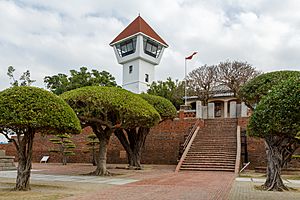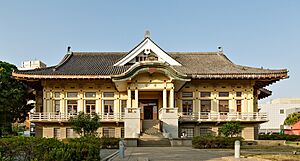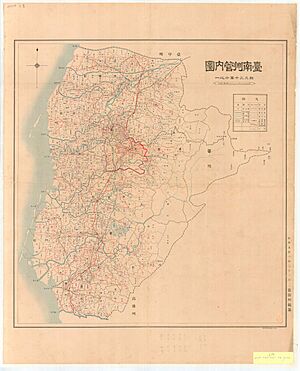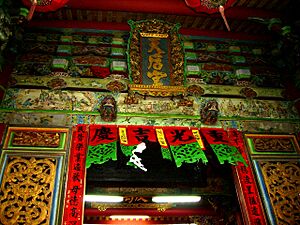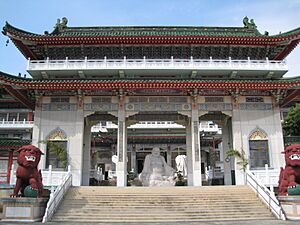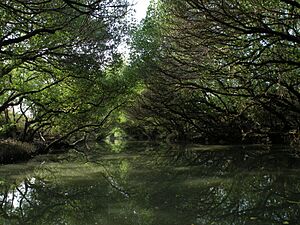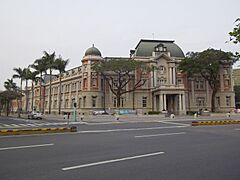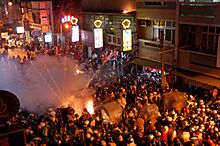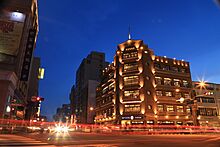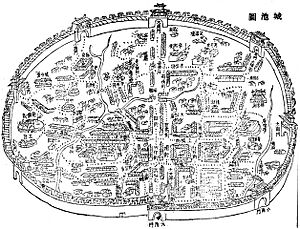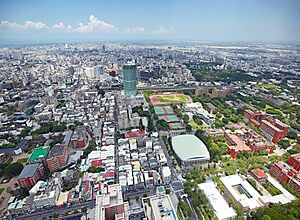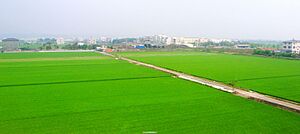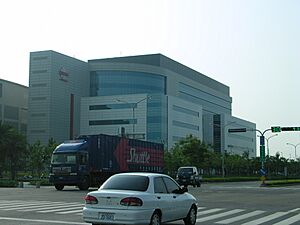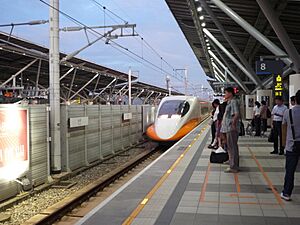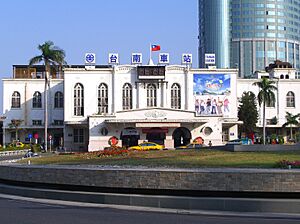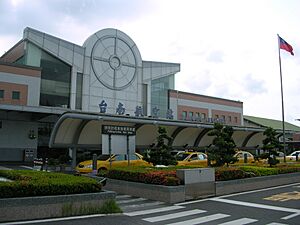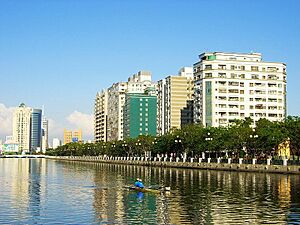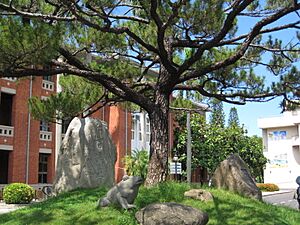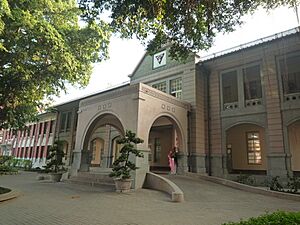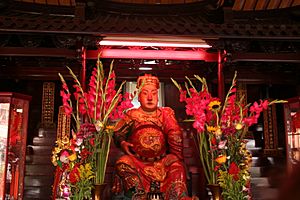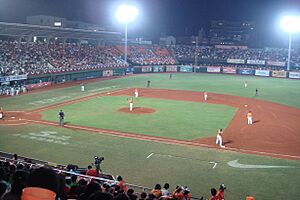Tainan facts for kids
Quick facts for kids
Tainan City
臺南市
Tâi-lâm
|
|||
|---|---|---|---|
|
Special municipality
|
|||
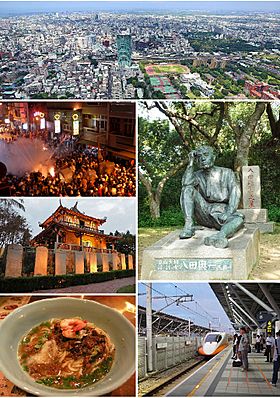
Clockwise from top: Downtown Tainan, statue of Yoichi Hatta, THSR Tainan Station, danzai noodles, Fort Provintia, beehive firework in Yanshuei
|
|||
|
|||
| Etymology: pinyin: Táinán; literally "Taiwan south" | |||
| Nickname(s): | |||
 |
|||
| Country | |||
| Formed under Fort Zeelandia | 1624 | ||
| Capital of Kingdom of Tungning | 1661 | ||
| Tainan Prefecture | 1895 | ||
| Provincial city status | 25 October 1945 | ||
| Upgraded to special municipality and merger with Tainan County | 25 December 2010 | ||
| Seat | Anping, Xinying | ||
| Districts |
37
Xinying
Yanshuei Baihe Liouying Houbi Dongshan Madou Xiaying Lioujia Guantian Danei Jiali Syuejia Sigang Cigu Jiangjun Beimen Sinhua Shanhua Sinshih Anding Shanshan Yujing Nansi Nanhua Zuojhen Rende Gueiren Guanmiao Longci Yongkang East South North Annan Anping West Central |
||
| Government | |||
| • Body |
|
||
| Area | |||
| • Special municipality | 2,191.65 km2 (846.20 sq mi) | ||
| • Urban | 259 km2 (100 sq mi) | ||
| Area rank | 7 out of 22 | ||
| Population
(March 2023)
|
|||
| • Special municipality | 1,856,642 | ||
| • Rank | 6 of 22 | ||
| • Density | 847.1435/km2 (2,194.092/sq mi) | ||
| • Urban | 1,205,000 | ||
| • Urban density | 4,653/km2 (12,050/sq mi) | ||
| Time zone | UTC+8 (National Standard Time) | ||
| Postal code |
700–745
|
||
| Area code(s) | (0)6 | ||
| ISO 3166 code | TW-TNN | ||
| Bird | Pheasant-tailed jacana | ||
| Flower | Phalaenopsis | ||
| Tree | Delonix regia | ||
| Tainan City | |||||||||||||||||||||||||||||
|---|---|---|---|---|---|---|---|---|---|---|---|---|---|---|---|---|---|---|---|---|---|---|---|---|---|---|---|---|---|
| Chinese name | |||||||||||||||||||||||||||||
| Traditional Chinese | 臺南市 | ||||||||||||||||||||||||||||
| Simplified Chinese | 台南市 | ||||||||||||||||||||||||||||
|
|||||||||||||||||||||||||||||
| Japanese name | |||||||||||||||||||||||||||||
| Hiragana | たいなんし | ||||||||||||||||||||||||||||
| Katakana | タイナンシ | ||||||||||||||||||||||||||||
| Kyūjitai | 臺南市 | ||||||||||||||||||||||||||||
| Shinjitai | 台南市 | ||||||||||||||||||||||||||||
|
|||||||||||||||||||||||||||||
Tainan is a special city in southern Taiwan. It faces the Taiwan Strait on its western side. Tainan is the oldest city on the island. People often call it the "prefectural capital." This is because it was the capital of Taiwan for over 260 years. It was the capital under Dutch rule, the Kingdom of Tungning, and later the Qing dynasty until 1887.
Tainan has a long history of changing and growing, which is why it's called "the Phoenix City." It's known as an important global city for its influence around the world.
As Taiwan's oldest city, Tainan started as a trading base called Fort Zeelandia in 1624. This was set up by the Dutch East India Company. Later, in 1662, a leader named Koxinga took over the Dutch fort. Tainan then became the capital of the Kingdom of Tungning until 1683. After that, it was the capital of Taiwan Prefecture under the Qing dynasty until 1887. The capital then moved to Taichung and later to Taipei.
After Taiwan was given to Japan in 1895, Tainan was the second capital of the short-lived Republic of Formosa. Under Japanese rule, it was the main city of Tainan Prefecture. After World War II in 1945, the Republic of China took control. Tainan became a provincial city. In 2010, Tainan City and Tainan County joined together to form a new special city.
Tainan is known as one of Taiwan's cultural centers. It has rich local traditions, famous street food, and many old customs. The city has Taiwan's first Confucian school–temple, built in 1665. You can also find parts of the old city gates and many other historical sites. Tainan has more Buddhist and Taoist temples than any other city in Taiwan.
Contents
- History of Tainan
- Tainan's Culture
- Explore Tainan: Tourism
- Tainan's Climate
- City Layout and Design
- Administrative Districts
- Tainan's Economy
- Getting Around Tainan: Transportation
- Learning in Tainan: Education
- Famous People from Tainan
- Sports in Tainan
- Tainan's Global Connections
- Where is Tainan?
- See also
History of Tainan
Ancient Times
Digs in Zuojhen District show that people lived in the Tainan area a very long time ago, possibly 20,000 to 31,000 years ago. By the 1500s, the Siraya tribe was in charge of the area. The Sakam people, a part of the Siraya tribe, lived where the city is today.
By the late 1500s, Chinese traders and fishermen set up bases along the coast. One important place was a sandbar called Taioan (now Anping). Japanese traders also had bases nearby. Both Chinese and Japanese traded with the Siraya people. They exchanged salt and food for deer hides. The Siraya people started using Chinese words and Japanese tools. They also moved inland as more newcomers arrived.
Dutch Colony in Tainan
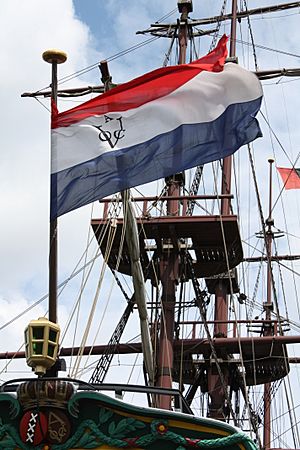
In 1624, the Dutch East India Company built a small fort called 'Orange' on a sandy peninsula. They later made it bigger and renamed it Fort Zeelandia. This fort was a base for trade between China, Japan, and Europe. In 1642, the Dutch took over a Spanish fort in Keelung. This made the Dutch East India Company the first group to control all of Formosa (Taiwan). Fort Zeelandia became the main government center.
The Dutch taxed the Chinese people in Taiwan heavily. This caused problems, leading to a revolt in 1652. The Dutch stopped the revolt with help from local tribes. In 1653, the Dutch built another fort, Fort Provintia, for farming. Many Chinese farmers came to Taiwan to grow rice and sugar cane. The Dutch settlement in southern Taiwan became very successful.
Kingdom of Tungning Era
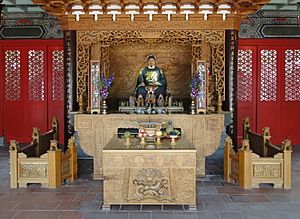
Koxinga was a loyal general who wanted to bring back the Ming dynasty. In 1661, he attacked the Dutch in Taiwan. After nine months, the Dutch gave up Fort Zeelandia in 1662. Koxinga then wanted to turn Taiwan into a military base for his loyalists.
Koxinga renamed Fort Provintia to Tungtu and Fort Zeelandia to Anping. He set up military farms to feed his soldiers. Many areas around Tainan City today have names like "Ying" or "Tian," which come from these farms. After Koxinga died in 1662, his son, Zheng Jing, took over. He changed the name of Dongdu to Dong Ning. His chief minister, Chen Yonghua, brought in Chinese government rules. He also built the first Confucius temple and taught people how to make salt. The British were invited to trade, which kept the area as an important trading hub.
Qing Dynasty Rule
After Zheng Jing died in 1681, there was a fight for power. The Qing navy took advantage of this and defeated the Tungning fleet in 1683. Taiwan then became part of the Qing Empire. The main city was called Taiwanfu (modern-day Tainan).
In 1721, Chinese farmers and local tribes rebelled against Qing rule. The rebels took Tainan easily. But they soon fought among themselves. A Qing army from mainland China had to come to restore order. The Qing government did not allow city walls in Taiwan. So, they grew bamboo around the city for defense. Later, in the late 1780s, they started building a city wall.
In 1823, a flood brought rich soil, creating new fertile land near Tainan. A canal system called Go-tiau-kang was built to keep the port working. In 1858, the Qing reopened Anping port for trade with Europeans. Western traders built posts near Fort Zeelandia.
After some Japanese sailors were killed in Taiwan in 1871, Japan sent an army. This showed how weak the Qing's control was. So, the Qing sent Shen Baozhen to Taiwan to make its defenses stronger. In Tainan, Shen invited French engineers to design the Eternal Golden Castle. He also suggested a telegraph line to connect Tainan with Amoy.
By 1885, the Qing government made Taiwan a province. The capital moved to Taichung. The old capital, Taiwanfu, was renamed Tainanfu.
Japanese Rule in Tainan
In 1895, China lost a war to Japan. Taiwan was given to Japan. The Republic of Formosa was declared in Tainan to try and stop the Japanese. But a Japanese army arrived in October 1895. Tainan was taken without a fight. Under Japanese rule, Tainan was first called Tainan Ken (臺南縣). In 1904, Tainan was Taiwan's most populated city with about 50,000 people.
A big uprising against the Japanese, called the Tapani Incident, started in 1915. It spread quickly and was supported by both Chinese and local Taiwanese people. The Japanese stopped the uprising. Many villages were destroyed, and thousands were killed. Over 800 people were sentenced to death in Tainan. This event changed Japanese policy in Taiwan.
The Japanese changed the city's name to Tainan Chō (臺南廳) in 1901, and then Tainan Shū (臺南州) in 1920. Tainan was the capital. The Japanese built modern things like schools, a courthouse, and new transportation. They also created wide streets and improved sanitation.
Republic of China Era
The Republic of China took over Taiwan in 1945 after World War II. Tainan City and Tainan County became separate areas in 1946. There was unrest in Tainan during the February 28 Incident in 1947. Like other parts of Taiwan, many people in Tainan suffered during the autocratic era if they were seen as opposing the government.
The city had its first elections in 1950. In the 1960s, Kaohsiung became the main economic center in southern Taiwan. This was because of the growth of Kaohsiung port. Tainan City faced challenges, but the areas outside the city grew. New industrial parks were built, and the city expanded.
In 1992, a plan to widen a road and build an underground plaza failed. This damaged a historic area. By the mid-1990s, people realized they needed to protect Tainan's history. The government and local groups have been working to save Tainan's heritage.
After the Southern Taiwan Science Park opened in 1995, the population in the city's outskirts grew fast. The city became more successful with new transport projects. The city center moved eastward. There are plans to make these new areas into business centers.
In 2009, the government approved a plan to combine Tainan County and Tainan City. On December 25, 2010, they merged to become the Tainan special municipality. In 2016, a strong earthquake hit the area, causing damage and sadly, many deaths.
Tainan's Culture

Tainan is known as one of Taiwan's cultural capitals. It has many old temples and unique ways of life. The city is full of Taoist and Buddhist temples, many of which are the oldest in Taiwan. Tainan also has its own traditions and foods that have grown over its long history.
Local Traditions
The lives of Tainan citizens are closely connected to many Chinese Deities and temples. Parents take their children to the "Weaving Maid Goddess" to wish them well. In Tainan, there's a special celebration for all 16-year-olds. It happens on the seventh day of the seventh lunar month, which is the goddess's birthday. This celebration is unique to Tainan.
Before exams, people visit the temple of Wenchangdijun, the God of Literature. They pray for good grades. Many high school students visit this temple in June before their university exams. People also visit temples to pray for good luck or to celebrate a god's birthday.
Wedding ceremonies in Tainan are very detailed. Both the groom and bride prepare 12 specific gifts. People believe this shows how civilized they are.
In Anping, people use a special symbol called the Sword Lion. It helps keep bad spirits away. Long ago, soldiers would put lion-face shields on their gates with swords. Locals still use this symbol on their houses for spiritual safety.
Delicious Cuisine
Tainan was the capital for over 200 years. This meant people developed a taste for many different foods. Portions are often bigger here than in other parts of Taiwan.
Many famous Taiwanese dishes started in Tainan. Since Tainan produced a lot of sugar, its food tends to be sweeter. For example, eel noodle soup has a sweet and sour taste. Milkfish dishes are very popular. Locals call it "Koxinga's fish." Many restaurants and snack stands in Tainan have been around since the Qing or Japanese eras.
On Guo Hua Street, you can find many local foods. These include "savory rich pudding" (碗粿), o-a-tsian (oyster omelet), gua bao, and popiah. Locals often eat these dishes in the morning or at noon.
Tainan is also a center for Taiwanese coffee. Coffee plants were first brought here in 1884 by the British.
Temples and Shrines
Tainan is famous for having many temples and shrines. Some of them are the only ones of their kind in Taiwan. There are officially seven Buddhist temples and eight Taoist shrines. As of 2015, Tainan has the most registered temples in Taiwan, with 1,613.
The seven Buddhist temples include:
- Kaiyuan Temple, which was once royal gardens.
- Zhuxi Temple, Fahua Temple, and Mituo Temple, all from the Tungning Kingdom period.
- Longshan Temple and Chongqing Temple, from the Qing dynasty.
- Huangbo Temple, which was torn down by the Japanese.
The eight Taoist shrines include:
- Grand Matsu Temple, dedicated to the Sea Goddess, Mazu.
- Sidian Wumiao, the Official Martial God temple, built in 1665.
- Dongyue Dian, the Lord of Underworld temple, built in 1673.
- Fuchenghuang Temple, the temple of the City God, built in 1669.
- Longwang Temple, dedicated to the Dragon King, built in 1716 but later torn down.
- Fongshen Temple, the God of Wind temple, built in 1739. This is the only one in Taiwan.
- Yaowang Temple, the God of Medicine temple, built in 1685.
- Shuisian Temple, the Water Deities temple, built during the Qing dynasty.
Many other famous temples are not on this list. Because there are so many temples, traditional temple decoration artists in Tainan are very skilled. They pass on their knowledge to keep the temples beautiful.
Music and Arts
Nanyin and Shisanyin were the first types of Chinese music in Tainan. Nanyin is for fun, while Shisanyin is for Confucius ceremonies. Tainan has two Nanyin clubs, one over 200 years old and another 95 years old.
Tainan City has its own Chinese orchestra and symphony orchestra. There are also private music groups.
The Ten Drum Art Percussion Group is a famous drumming group started in 2000. They perform music that tells stories about Taiwan's history and culture. They have performed around the world. The group has its own campus in an old sugar factory. They teach drumming and offer regular shows.
Museums and Parks
Tainan has many museums and parks. The National Museum of Taiwan Literature is in the old city hall. The National Museum of Taiwan History is in Annan district. The Chimei Museum is in Rende district. Taijiang National Park is along the coast. The Anping Historic Scenic Park covers the old Anping town. The Siraya National Scenic Area includes the Wusanto Reservoir. In the city center, you can find many historical sites from different eras. These include the Confucius temple and old city gates.
Explore Tainan: Tourism
Tainan has a strong sense of history and hosts amazing religious festivals. It was Taiwan's first capital and has about 300 old temples. These range from the first Confucian temple to the first Taoist temple on the island.

Taiwan Confucian Temple
The Taiwan Confucian Temple was built in 1665 by Cheng Ching, Koxinga's son. It was made to teach and train smart people. It was the first learning place for children when the Qing dynasty ruled Taiwan. So, it's also called the First Academy of Taiwan.
The temple is a popular place for visitors. It keeps old Confucian ceremonies alive, which are performed regularly. The temple grounds have rooms for the tools and musical instruments used in these ceremonies.
National Museum of Taiwan History
The National Museum of Taiwan History is in the Annan District. It opened in 2011. This museum collects, organizes, saves, researches, and shows items related to Taiwan's history and culture. It's for both locals and visitors.
National Museum of Taiwan Literature
The National Museum of Taiwan Literature studies, lists, saves, and shows local literary items. It focuses on different languages and cultures. The museum is in the old Tainan City Hall, built in 1916. This building is famous for its history.
Fort Provintia
Fort Provintia was built in 1653 by the Dutch. They built it during their time ruling Taiwan. Later, it was given to Koxinga. Since 1945, the site has been called "Chihkan Tower." This name comes from "Sakam," the name of the area.
Besides its beautiful buildings, the site has old books of dictionaries and business records. These documents show the Siraya language, which was spoken by the native people during Dutch rule.
Shopping and Fun
Tainan is a large city, so it has many department stores, shopping malls, and fancy shops. Many well-known brands have stores here.
Flower Night Market is one of Taiwan's most famous Night markets in Taiwan. It's often thought to be the biggest. But unlike others, it's only open three days a week: Thursday, Saturday, and Sunday.
Beehive Fireworks
In Yanshuei District, the most important fireworks during the Lantern Festival are called "beehives." These are many bottle rockets put together in a metal and wood frame. When lit, rockets shoot out fast in all directions. This creates a dazzling and exciting show for everyone watching.
Tainan's Climate
Tainan has a warm humid subtropical climate. This means it has mild, dry winters and hot, humid summers. South of the city, the climate changes from subtropical to tropical.
| Climate data for Tainan (1991–2020 normals, extremes 1897–present) | |||||||||||||
|---|---|---|---|---|---|---|---|---|---|---|---|---|---|
| Month | Jan | Feb | Mar | Apr | May | Jun | Jul | Aug | Sep | Oct | Nov | Dec | Year |
| Record high °C (°F) | 32.4 (90.3) |
32.8 (91.0) |
36.1 (97.0) |
35.4 (95.7) |
37.2 (99.0) |
37.8 (100.0) |
37.2 (99.0) |
37.2 (99.0) |
36.6 (97.9) |
36.0 (96.8) |
35.2 (95.4) |
32.9 (91.2) |
37.8 (100.0) |
| Mean daily maximum °C (°F) | 22.9 (73.2) |
24.0 (75.2) |
26.5 (79.7) |
29.3 (84.7) |
31.4 (88.5) |
32.4 (90.3) |
33.1 (91.6) |
32.6 (90.7) |
32.5 (90.5) |
30.8 (87.4) |
28.1 (82.6) |
24.4 (75.9) |
29.0 (84.2) |
| Daily mean °C (°F) | 17.8 (64.0) |
18.9 (66.0) |
21.6 (70.9) |
24.9 (76.8) |
27.5 (81.5) |
28.9 (84.0) |
29.4 (84.9) |
28.9 (84.0) |
28.6 (83.5) |
26.3 (79.3) |
23.4 (74.1) |
19.6 (67.3) |
24.7 (76.4) |
| Mean daily minimum °C (°F) | 14.5 (58.1) |
15.5 (59.9) |
18.0 (64.4) |
21.7 (71.1) |
24.7 (76.5) |
26.3 (79.3) |
26.7 (80.1) |
26.3 (79.3) |
26.0 (78.8) |
23.3 (73.9) |
20.3 (68.5) |
16.3 (61.3) |
21.6 (70.9) |
| Record low °C (°F) | 2.6 (36.7) |
2.4 (36.3) |
5.1 (41.2) |
8.9 (48.0) |
14.7 (58.5) |
18.9 (66.0) |
21.1 (70.0) |
19.3 (66.7) |
15.4 (59.7) |
12.6 (54.7) |
2.9 (37.2) |
4.3 (39.7) |
2.4 (36.3) |
| Average precipitation mm (inches) | 20.9 (0.82) |
23.7 (0.93) |
31.1 (1.22) |
69.1 (2.72) |
160.1 (6.30) |
369.5 (14.55) |
353.5 (13.92) |
478.9 (18.85) |
167.6 (6.60) |
24.6 (0.97) |
26.9 (1.06) |
15.6 (0.61) |
1,741.5 (68.55) |
| Average precipitation days (≥ 0.1 mm) | 3.9 | 4.2 | 4.3 | 5.7 | 9.0 | 12.2 | 12.5 | 15.8 | 8.0 | 2.4 | 2.6 | 2.7 | 83.3 |
| Average relative humidity (%) | 75 | 75.5 | 73.8 | 74.6 | 75.3 | 77.2 | 76.1 | 78.3 | 75.2 | 72.8 | 74.5 | 73.7 | 75.2 |
| Mean monthly sunshine hours | 177.5 | 163.4 | 180.7 | 178.2 | 195.8 | 196.3 | 208.8 | 175.4 | 184.8 | 201.1 | 170.6 | 170.3 | 2,202.9 |
| Source: Central Weather Bureau | |||||||||||||
City Layout and Design
The Great Cross Street
The first city plan was made by Dutch colonist Cornelis Jansz. Plockhoy. He designed a wide main street (today's Minquan Rd Sec. 2). Other roads branched out into farming areas. Later, a Chinese settlement's main street crossed this one. This created the Shizi Dajie, or The Great Cross Street.
When the Ming dynasty fell, many new people moved to Tainan. The Chinese population grew from 5,000 to 35,000 between 1640 and 1661. Farmers, hunters, traders, and craftspeople each formed their own groups on the cross street.
Because different trades and regions worshipped different Taoist gods, the city grew into neighborhoods. Each had its own main temple. Now, Tainan is a showcase of Taoist and Chinese Buddhist temples. Even though the city has changed a lot, the temples remain important to locals. Some old government buildings even became temples.
Japanese City Plan
The modern look of Tainan was shaped by urban plans from the Japanese government. The city center used a Baroque design, similar to how Paris was rebuilt. This plan connected important buildings with wide streets and five roundabouts.
The most important crossing point was Taishō Park (大正公園, modern-day Tang Te-chang Memorial Park). This park was surrounded by the city hall, fire station, and weather office. It connected to avenues leading to the train station, airport, military bases, and the port. This area showed the power of the Japanese government. The main shopping street was Ginzadōri (modern-day Zhongzheng Rd). Many old buildings from the Japanese era can still be seen here.
Three Ring Belts
City planners used a "three-belt system" for Tainan. These were the green boulevard ring, the blue belt Anping canal, and the Zhonghua road system. The green boulevard connected parks and universities. The Zhonghua Road system connects new areas around the old city center. The Anping canal "blue belt" was created after a big development project. This project created an artificial island called "New Anping." Many tall buildings are now built along these three rings.
Regions of Tainan
Beyond the city center, Tainan is divided into two main parts: the River South Region and the River North Region. The Zengwen River separates them.
The River South Region is part of the Tainan metropolitan area. Towns spread out from the city center here. The Southern Taiwan Science Park is in the north of this region. This area is expected to keep growing.
The River North Region is a major farming area in Taiwan. It has several important centers like Xinying, Yujing, Jiali, and Madou.
Xinying was the main government center for the old Tainan County. Yujing is known for its mangoes. Jiali is the center for coastal Tainan. Madou is in the lower plain area and was home to the Mattauw tribe.
Administrative Districts
Tainan uses special spellings for its street and district names. Tainan has 37 districts, which is the second most in Taiwan.
| Map of Tainan | ||||||
|---|---|---|---|---|---|---|
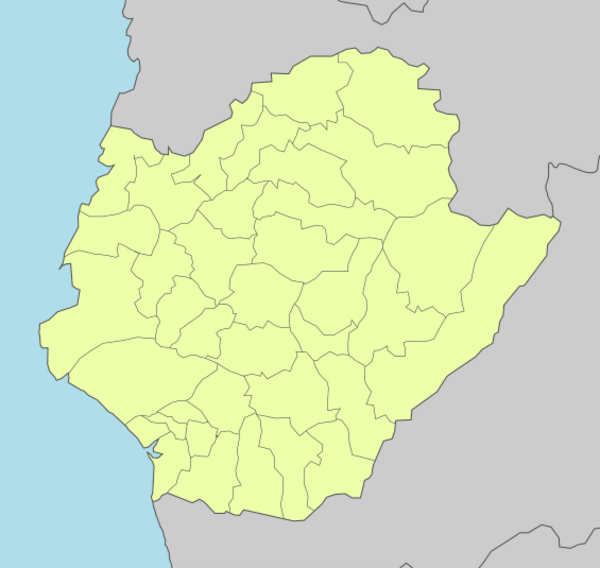
Anding
Annan
Anping
Baihe
Beimen
Danei
Dongshan
East
Guanmiao
Guantian
Gueiren
Houbi
Jiali
Jiangjun
Lioujia
Image label small|x=-350.0|y=-168.0|scale=-1|text=Liouying}} Longci
Madou
Nanhua
Nansi
North
Cigu
Rende
Shanhua
Shanshang
Sinhua
South
West-
Cen.
Xiaying
Sigang
Sinshih
Xinying
Syuejia
Yanshuei
Yongkang
Yujing
Zuojhen
Image label small|x=-580.0|y=-560.0|scale=-1|text=Pingtung County}} |
||||||
| Region | Name | Chinese | Taiwanese | Hakka | Population (January 2023) | Area (km2) |
| Inner Tainan |
West Central | 中西區 | Tiong-se | Chûng-sî | 77,487 | 6.2600 |
| East | 東區 | Tang | Tûng | 180,828 | 14.4281 | |
| South | 南區 | Lâm | Nàm | 121,212 | 27.2681 | |
| North | 北區 | Pak | Pet | 126,229 | 10.4340 | |
| Anping | 安平區 | An-pêng | An-phìn | 68,217 | 11.0663 | |
| Annan | 安南區 | An-lâm | An-nàm | 199,502 | 107.2016 | |
| River South Region |
Yongkang | 永康區 | Éng-khong | Yún-không | 234,351 | 40.275 |
| Gueiren (Guiren) | 歸仁區 | Kui-jîn | Kûi-yìn | 68,140 | 55.7913 | |
| Sinhua (Xinhua) | 新化區 | Sin-hòa | Sîn-fa | 42,523 | 62.0579 | |
| Zuojhen (Zuozhen) | 左鎮區 | Chó-tìn | Tsó-tsṳ́n | 4,361 | 74.9025 | |
| Yujing | 玉井區 | Gio̍k-chéⁿ | Ngiu̍k-tsiáng | 13,121 | 76.366 | |
| Nansi (Nanxi) | 楠西區 | Lâm-se | Nàm-sî | 8,853 | 109.6316 | |
| Nanhua | 南化區 | Lâm-hòa | Nàm-fa | 8,112 | 171.5198 | |
| Rende | 仁德區 | Jîn-tek | Yìn-tet | 76,983 | 50.7664 | |
| Guanmiao | 關廟區 | Koan-biō | Kûan-meu | 33,436 | 53.6413 | |
| Longci (Longqi) | 龍崎區 | Liông-kiā | Liùng-khì | 3,600 | 64.0814 | |
| Shanhua | 善化區 | Siān-hòa | San-fa | 51,900 | 55.309 | |
| Shanshang | 山上區 | San-siōng | Sân-song | 6,975 | 27.8780 | |
| Sinshih (Xinshi) | 新市區 | Sin-chhī | Sîn-sṳ | 37,534 | 47.8096 | |
| Anding | 安定區 | An-tēng | Ôn-thin | 29,914 | 31.2700 | |
| Coastal Tainan |
Jiali | 佳里區 | Ka-lí | Kâ-lî | 58,124 | 38.9422 |
| Sigang (Xigang) | 西港區 | Sai-káng | Sî-kóng | 24,716 | 33.7666 | |
| Cigu (Qigu) | 七股區 | Chhit-kó͘ | Tshit-kú | 21,471 | 110.1492 | |
| Jiangjun (Jiangjyun) | 將軍區 | Chiong-kun | Tsiông-kiûn | 18,620 | 41.9796 | |
| Syuejia (Xuejia) | 學甲區 | Ha̍k-kah | Ho̍k-kap | 24,747 | 53.9919 | |
| Beimen | 北門區 | Pak-mn̂g | Pet-mùn | 10,191 | 44.1003 | |
| River North Region |
Guantian | 官田區 | Koaⁿ-tiān | Kôn-thièn | 20,866 | 70.7953 |
| Madou | 麻豆區 | Môa-tāu | Mà-theu | 42,956 | 53.9744 | |
| Xinying (Sinying) | 新營區 | Sin-iâⁿ | Sîn-yàng | 74,972 | 38.5386 | |
| Houbi | 後壁區 | Āu-piah | Heu-piak | 21,865 | 71.2189 | |
| Baihe | 白河區 | Pe̍h-hô | Pha̍k-hò | 26,210 | 126.4046 | |
| Dongshan | 東山區 | Tong-san | Tûng-sân | 19,367 | 124.91 | |
| Lioujia (Liujia) | 六甲區 | La̍k-kah | Liuk-kap | 21,360 | 64.5471 | |
| Xiaying (Siaying) | 下營區 | Ē-iâⁿ | Ha-yàng | 22,649 | 33.5291 | |
| Liouying (Liuying) | 柳營區 | Liú-iâⁿ | Liú-yàng | 20,408 | 61.2929 | |
| Yanshuei (Yanshui) | 鹽水區 | Kiâm-chúi | Yàm-súi | 24,447 | 52.2455 | |
| Danei | 大內區 | Tōa-lāi | Thai-nui | 8,845 | 70.3125 | |
Annan District was once part of Tainan County. It joined Tainan City in 1946. In 2004, Central District and West District combined to form the new West Central district.
Tainan's Economy
Industries in Tainan
Tainan used to rely on old-style factories. But after the Southern Taiwan Science Park opened in 1995, it became a big center for high-tech industries. Companies here work on things like screens, computer chips, green energy, and new medicines. Big companies like Chimei-Innolux and TSMC are located here. Tainan is now a major hub for the screen industry in Taiwan.
Tainan is still important for making car parts, processing food, textiles, and plastics. Companies like Uni-President and Chi Mei have their main offices in the city. In 2010, industrial production made up 62.6% of the city's total economy.
Farming and Food
Farming is very important to Tainan, especially in the River North Region. Coastal areas focus on fishing and fish farming. Inland areas have rice and fruit farms. The city is famous for its milkfish, oysters, rice, mangoes, and pineapples. A government-funded research center helps farmers. The main office of the World Vegetable Center, which helps improve crops in poorer countries, is in Shanhua District.
Salt and sugar production used to be big industries, but they are now less important. Companies like Taiyen and Taiwan Sugar Corp. have changed to focus on new areas like biotechnology and tourism.
Orchid growing is a very important farming industry. Tainan's orchids are famous worldwide. A special growing area with research facilities is in Houbi District.
Tourism and Shopping
Tourism is becoming more and more important in Tainan. As Taiwan's first capital, it has many historical and cultural sites to explore. In the first half of 2013, over 7 million tourists visited the city. Tainan has fancy hotels, like the Shangri-la Hotel. It is also well-known for its variety of Xiaochi (small eats).
Retail and services provide the most jobs in Tainan, about 52% in 2010. The city center has five department stores. There are also shopping areas in other districts like East, North, and Yongkang. The 'Dream Mall' is a large shopping center that opened in 2015. It is in a new business area of the city.
Getting Around Tainan: Transportation
Train Travel
Tainan Station is a main stop on the Taiwan Railways Administration (TRA) Western Line. You can take direct trains to Taipei, Kaohsiung, and other major cities. Local trains also connect to nearby places.
The Taiwan High Speed Rail's Tainan Station is a bit outside the city center, in Gueiren District. You can get to the city center using the TRA Shalun Line or special shuttle buses. Using the High Speed Rail, you can reach Taipei in less than 90 minutes.
Public Buses
Tainan has three main bus companies. In 2012, the city government planned a new Tainan City Bus System. This system, which started in 2013, has six main routes connecting the city. These routes then spread out into 66 smaller routes to serve local communities. The city hopes this new system will encourage more people to use public transport.
There's also a project to move the railway in the city center underground. This will help trains run more often and reduce traffic problems. Two new stations are planned for East district commuters. This railway section will become a key part of Tainan's train system.
Roads and Highways
National Highway Nos. 1 and 3 connect to Tainan City. Tainan City has about 142.9 kilometers of highways, including national, local, and rural roads.
Air Travel
Tainan Airport (TNN) is in the South District, only about 6 kilometers from the city center. It's a regional airport with flights to places like Hong Kong, Ho Chi Minh City, and Osaka.
Learning in Tainan: Education
Tainan has many schools and universities.
- National Cheng Kung University (國立成功大學) is famous for its engineering programs. It started in 1931 and is now a national university with nearly 21,000 students. It ranks high in Taiwan and Asia.
- National University of Tainan (國立臺南大學) started as a teachers' institute in 1988 and became a university in 2004.
- Tainan National University of the Arts (國立臺南藝術大學) helps talented students in visual and performing arts. It opened in 1996.
- National Yang Ming Chiao Tung University (國立陽明交通大學) has a campus in Tainan, established in 2009.
- Tainan Theological College and Seminary was founded in 1876.
- Chang Jung Christian University is a private university that aims to promote fairness and service. It's in Gueiren.
- Southern Taiwan University of Science and Technology (南臺科技大學) was founded in 1969.
- The Tainan University of Technology (臺南應用科技大學) is a private university founded in 1964.
- Aletheia University is a private university founded in 1882. It has a branch in Madou District.
- CTBC Business School is a private university that focuses on business.
- Taiwan Shoufu University is a private university with colleges for education, leisure, and hotel management.
- University of Kang Ning is a private university established in 2011.
Elementary Schools
Public
- Yuwen Elementary School
- Fusing Elementary School
Junior High Schools
Public
- Tainan Municipal Fusing Junior High School
- Tainan Municipal Chongming Junior High School
- Tainan Municipal Jhongsiao Junior High School
- Tainan Municipal Houjia Junior High School
- Tainan Municipal Anping Junior High School
- Tainan Municipal Jiansing Junior High School
- Tainan Municipal Jincheng Junior High School
- Tainan Municipal Jhongshan Junior High School
- Tainan Municipal Minde Junior High School
- Tainan Municipal Wunsian Junior High School
- Tainan Municipal Yanping Junior High School
- Tainan Municipal Chenggong Junior High School
- Tainan Municipal Sinsing Junior High School
- Tainan Municipal Dacheng Junior High School
Senior High Schools
Public
- National Tainan First Senior High School
- National Tainan Second Senior High School
- National Tainan Girls' Senior High School
- National Hsin Hua Senior High School
- National Chia-Chi Girls' Senior High School
- National Tainan Commercial Vocational School
- National Tainan Industrial Vocational School
- The Affiliated Senior Industrial Vocational Continuing Education High School of National Cheng Kung University
- National Tainan Marine & Fishery Vocational School
- Municipal Tainan Nan-Ning Senior High School
- Municipal Tainan Tu-Cheng High School
- Tainan Municipal Nanning Senior High School
Private
- Feng-Ho Senior High School
- Chang Jung High School
- Sheng Kung Girls' High School
- Nan Ying Vocational High School of Business & Technology
- Salesian Technical School
- Chang Jung Girls' Senior High School
- Deguang Catholic High School
- Kuang Hua Girls' Senior High School
- Tainan Liuhsin Senior High School
- Kuen-Shan Senior High School
- Ying-Hai High School
Famous People from Tainan

Many well-known people were born, studied, or became famous in Tainan. Here are a few:
- Shone An (1983–2015), a singer and actor.
- Momofuku Ando (1910–2007), who invented instant noodles.
- Thomas Barclay (1849–1935), a Christian missionary who lived in Tainan for many years.
- William Campbell (1841–1921), another Christian missionary.
- Chin-Feng Chen (born 1977), the first Taiwan-born player in Major League Baseball.
- Chen Wei-ling, an Olympic bronze medal-winning weightlifter.
- Hong-Chih Kuo, a former MLB pitcher.
- Tai-Yuan Kuo, a famous baseball pitcher.
- Chou Tzu-yu (born 1999), a singer and the youngest member of the K-pop group Twice.
- Judy Ongg (born 1950), an actress, singer, and artist.
- Shi Wen-long (born 1928), who founded Chi Mei Corporation.
- Lisa Su (born 1969), the CEO of Advanced Micro Devices.
- Chien-Ming Wang, a former MLB pitcher for the New York Yankees.
- Jacky Wu (born 1962), a popular entertainer.
- Jensen Huang (born 1963), the CEO of NVIDIA.
- Crowd Lu (born 1985), a singer-songwriter and actor.
Sports in Tainan
Tainan is home to the Uni-President Lions, a professional baseball team. They play their home games at the Tainan Municipal Baseball Stadium. Tainan is also where many famous Taiwanese baseball players were born, like Chien-Ming Wang and Hong-Chih Kuo.
Tainan also has a professional basketball team, the Tainan TSG GhostHawks, who play in the T1 League.
Tainan has hosted the U-12 Baseball World Cup since 2015. Other big sports events held here include:
- The 2004 World University Baseball Championship
- The 2008 World University Archery Championships
Tainan's Global Connections
Sister Cities
Tainan City has many sister cities around the world. These are cities that have special friendly relationships.
 Monterey, California, United States (1965)
Monterey, California, United States (1965) Gwangju, South Korea (1968)
Gwangju, South Korea (1968) San Jose, California United States (1977)
San Jose, California United States (1977) Kansas City, Missouri United States (1978)
Kansas City, Missouri United States (1978) Columbus, Ohio United States (1980)
Columbus, Ohio United States (1980) Cavite City, Philippines (1980)
Cavite City, Philippines (1980) Tagaytay, Philippines (1980)
Tagaytay, Philippines (1980) Trece Martires, Philippines (1980)
Trece Martires, Philippines (1980) Pasay, Philippines (1980)
Pasay, Philippines (1980) Santa Cruz de la Sierra, Bolivia (1981)
Santa Cruz de la Sierra, Bolivia (1981) Nelson Mandela Bay, South Africa (1982)
Nelson Mandela Bay, South Africa (1982) Orlando, Florida United States (1982)
Orlando, Florida United States (1982) Gold Coast, Queensland, Australia (1982)
Gold Coast, Queensland, Australia (1982) Fairbanks, Alaska United States (1983)
Fairbanks, Alaska United States (1983) Laredo, Texas United States (1985)
Laredo, Texas United States (1985) Oklahoma City, Oklahoma, United States (1986)
Oklahoma City, Oklahoma, United States (1986) Huntsville, Alabama United States(1986)
Huntsville, Alabama United States(1986) Carbondale, Illinois United States(1991)
Carbondale, Illinois United States(1991) Leuven, Belgium (1993)
Leuven, Belgium (1993) Snohomish County, Washington United States (1998)
Snohomish County, Washington United States (1998) Ra'anana, Israel (1999)
Ra'anana, Israel (1999) Zacapa, Guatemala (2003)
Zacapa, Guatemala (2003) Elbląg, Poland (2004)
Elbląg, Poland (2004) Keçiören, Turkey (2005)
Keçiören, Turkey (2005) Esbjerg, Denmark (2005)
Esbjerg, Denmark (2005) Cagayan de Oro, Philippines (2005)
Cagayan de Oro, Philippines (2005) Wotje Atoll, Marshall Islands (2018)
Wotje Atoll, Marshall Islands (2018) Beziers City, Hérault Department, France (2023)
Beziers City, Hérault Department, France (2023)
Friendship Cities
Tainan City also has friendly relationships with other cities, even if they aren't official sister cities.
 Sendai, Japan (2006)
Sendai, Japan (2006) Nikkō, Tochigi, Japan (2009)
Nikkō, Tochigi, Japan (2009) Almere, Netherlands (2009)
Almere, Netherlands (2009) Minakami, Gunma, Japan (2013)
Minakami, Gunma, Japan (2013) Arizona, United States (2013)
Arizona, United States (2013) Shiga, Japan (2013)
Shiga, Japan (2013) Parramatta, Australia (2014)
Parramatta, Australia (2014) Kaga, Ishikawa, Japan (2014)
Kaga, Ishikawa, Japan (2014) Styria, Austria (2015)
Styria, Austria (2015) Chandler, Arizona, United States (2016)
Chandler, Arizona, United States (2016) Fujinomiya, Shizuoka, Japan (2017)
Fujinomiya, Shizuoka, Japan (2017) Aomori Prefecture, Japan (2017)
Aomori Prefecture, Japan (2017) Hirosaki, Aomori, Japan (2017)
Hirosaki, Aomori, Japan (2017) Yamagata, Yamagata, Japan (2017)
Yamagata, Yamagata, Japan (2017) Tsuchiura, Japan (2023)
Tsuchiura, Japan (2023) Gyeongju, North Gyeongsang Province, Korea (2024)
Gyeongju, North Gyeongsang Province, Korea (2024) Jonava, Kaunas County, Lithuania (2024)
Jonava, Kaunas County, Lithuania (2024) Hirado, Japan (2024)
Hirado, Japan (2024) Naka, Ibaraki, Japan (2024)
Naka, Ibaraki, Japan (2024) Furano, Hokkaido, Japan (2024)
Furano, Hokkaido, Japan (2024)
Domestic Friendships
 Kinmen, Fujian (1981)
Kinmen, Fujian (1981) Penghu County, Taiwan (2004) (Friendship city)
Penghu County, Taiwan (2004) (Friendship city)
Where is Tainan?
 |
 |
|||
| Taiwan Strait | ||||
See also
 In Spanish: Tainan para niños
In Spanish: Tainan para niños




